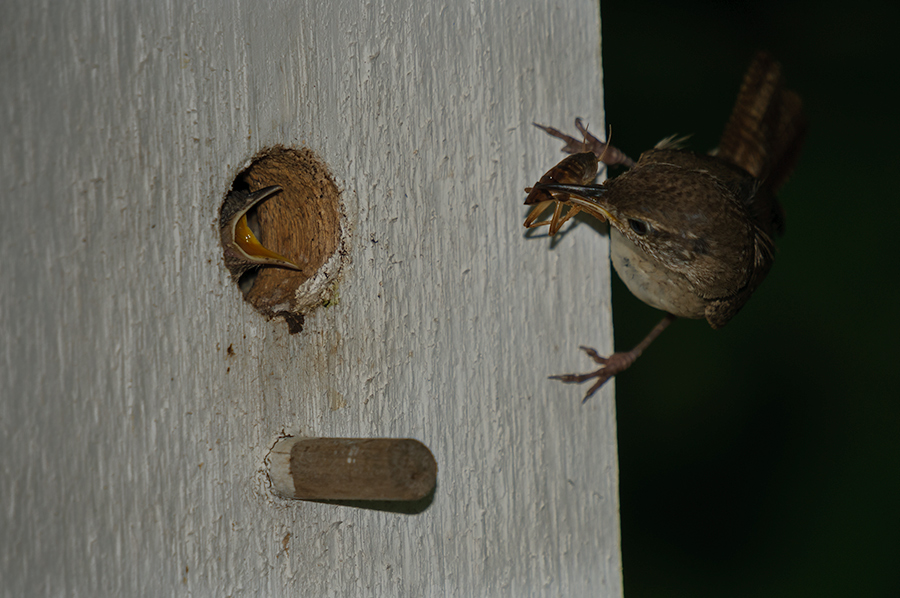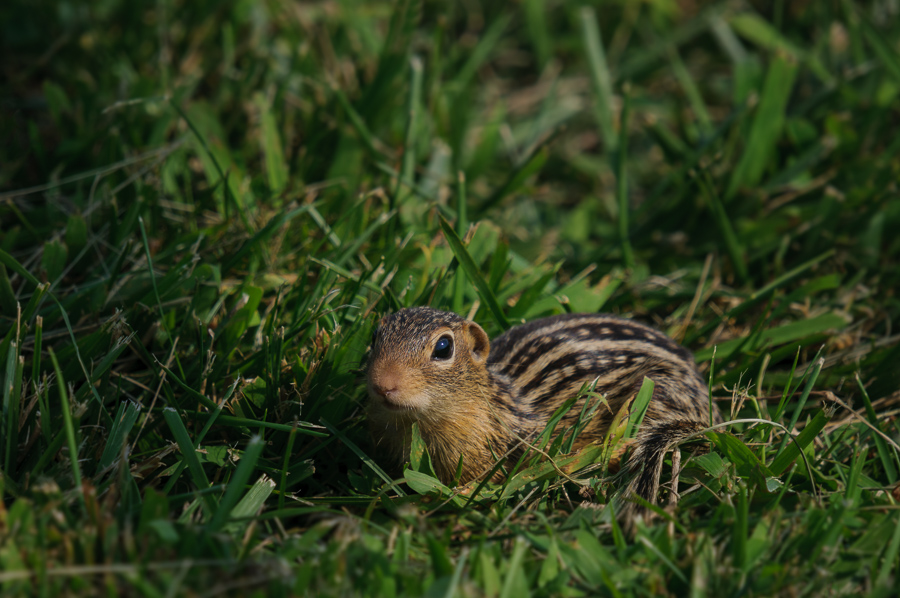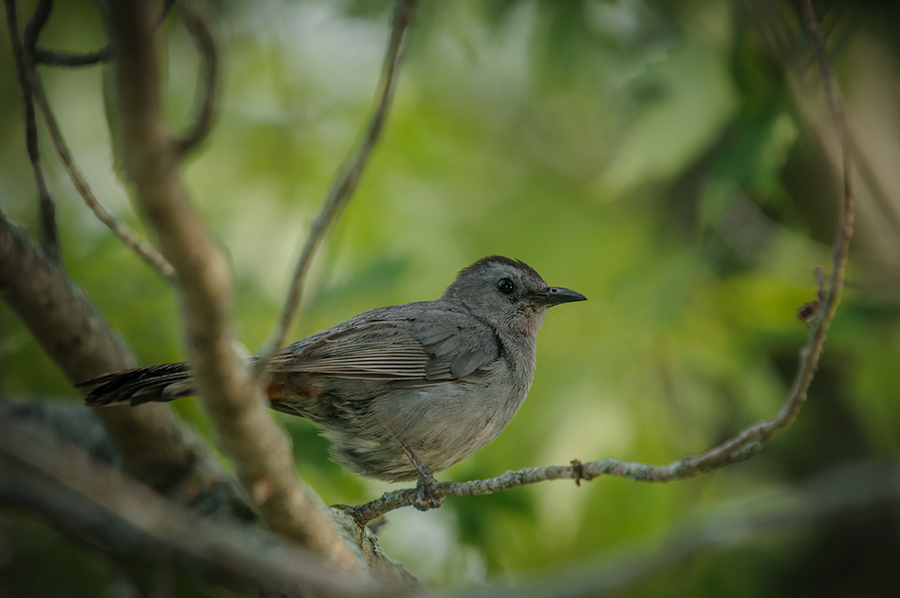
It was still feeding time yesterday and this morning at the wren bird box. I was too busy with other things this evening and don’t know if the young House Wrens have left their nest today or not. I guess I’ll find out tomorrow morning… ;-)

It was still feeding time yesterday and this morning at the wren bird box. I was too busy with other things this evening and don’t know if the young House Wrens have left their nest today or not. I guess I’ll find out tomorrow morning… ;-)

When I told you a few days ago that it will be quiet for the rest of the summer, because the little House Wrens had left their nest box, I did not know that in one of the other boxes at the edge of the woods another female was still sitting on her eggs. Well, since a few days we can hear their hungry chatter and the parents deliver insects and spiders every few minutes. We are very happy that we had four successful broods just within the range of our house this year. The parents approach the box always very carefully, especially if there is a guy with a tripod and camera not far from the nest.
I highly respect their privacy and use the full range of the long lens to make these images. By watching them for a while I knew that the old birds would always first land in a shrub nearby, then fly to a tree branch above the nest, before they finally go to the hole in the box with their food. Knowing the critters biology and habits leads to more photo opportunities and quite often to better results.

Although we have swallowtail butterflies in considerable numbers here in our neck of the woods since quite a few weeks, it’s getting more difficult to make a decent photo of one of them. No, it’s not the light, which can be quite harsh in early August sometime, but they just look frayed towards the end of their life span. The photos I show you today are already a few days old and the butterflies still appeared in their full beauty.

You may look at the images and think, these are two different species, but they are all Eastern Tiger Swallowtails. While the males are always yellow, the females can be either yellow or black. I have not seen a black female very often but it seems this year one is paying us a visit every day.
Thank you for stopping here in the blog. I wish all of you a wonderful summer week!


I had some other things in mind for today’s blog post but this one is fresh out of the camera. I went to the Mississippi this evening again and wanted to check if the Sandhill Cranes use the same spot as last year to spend the night. It was a nice tour with the kayak but I didn’t see or hear any cranes. Instead this Great Blue Heron was standing in the reeds where the cranes used to rest for the night.
The sun was diffused by a cloud and the light was nice and soft. I used a little fill flash in order to manage 1/250s of exposure time and to boost the colors. Remember, in the boat I have to handhold the heavy lens and shooting with a slower speed didn’t deliver a sharp image today.

Beside having great fun to paddle the Upper Iowa River last weekend another area drew our attention Saturday evening. Cardinal Marsh State Wildlife Area in Winneshiek County was not very far away from our campsite. I read about some interesting bird sightings there recently and wanted to find and explore it while we visited the area.

We saw geese, herons, several shore birds, and probably a vireo, most of them far away, and we didn’t have enough time before sunset to make a halfway decent approach to get closer. The marsh with its ponds and meadows is definitely a place I like to revisit with more time on-hand.
It was a great delight for us to discover a couple of Sandhill Cranes and I got totally excited when they started to perform one of their their dancing displays, which lasts about thirty seconds. Here is what I found about it on the website of the National Wildlife Federation:
>> Sandhill cranes mate for life. When they form a pair bond, it can last for years until one of the cranes dies. After a mate passes away, the surviving crane will seek out a new mate. In the early spring, as sandhill cranes are migrating to their breeding grounds, single cranes will start pairing up. A sandhill crane pair performs unison calling to create a bond. When the pair reaches the northern breeding grounds, they mate and build a nest. During mating, sandhill cranes perform dancing displays. Although the dancing is most common in the breeding season, the cranes can dance all year long. Sometimes the dance involves wing flapping, bowing, jumps and simply playing around. They might also throw a stick or some plants into the air. <<

Many of us have probably seen this ritual on TV sometime, but seeing it in real time was a very emotional moment for us. Technically seen, today’s photos are far from even my “amateur standards”. Distance and the short time window just before sunset have set the limits to work the subject harder. This is the best a Sigma 50-500 can perform under the circumstances and the photos are even a little bit cropped. It is the story telling of these images in a wonderful soft and warm light why I like to show them anyway. I hope you enjoy!


This is our “house frog”, a little Common Gray Tree Frog. It lives on our balcony, under a canopy of grape vine leaves and between flower pots that we have outside during the summer. The 4 - 5 cm long (1.5 - 2 inch) frog is always good for a surprise and we see it quite often. The Gray Tree Frog can change its color in seconds and this helps it to blend in with tree bark or leaves. They are nocturnal and spend the day resting in trees and shrubs, or like this one, in the plants on our balcony. One of the most interesting facts is that the frog is capable of surviving freezing of their internal body fluids to temperatures as low as -8°C (17.6°F).

It took me quite some time to figure out how to light my subject and to make these photos in very low light between the branches of a Crassula ovata plant. Luckily the frog was cooperative and didn’t move too much. The best results were obtained by using a camera off flash, pointing upward, and using just the light that bounced back from the grapevine leaves that grow above.

My instinct told me yesterday, take some pictures of the House Wrens, who were feeding their second brood this summer, because the young birds may leave the nest within the next few days. I’m glad I did, since it happened much faster than I thought. Early this morning I heard the parent birds calling the offspring out of the nest. At 7:30AM it was empty. Later during the day I heard them still chatter in the bushes around here and the parents do of course still feed them.

There is no other bird I have studied and photographed more than the little House Wrens during the last years. They raise the first brood every year in one of the bird boxes in the flower bed in front of our house. For the second one they prefer a hollow gourd that hangs from our porch.
There were at least two young wrens in the gourd, and boy, they were hungry. The little guys were calling for more food all day long and the parents of course delivered…
It will be quiet from now on in the morning for the rest of the summer. But when the snow starts falling later in the year we begin dreaming about the first signs of spring. The arrival and chatter of our House Wrens is definitely one of them…

What was the key for making this photo? Well, leave Cooper, our dog, in the car! If you don’t know what I’m talking about please read the blog post I wrote two days ago. Here is the link if you missed this one.
The Thirteen-lined Ground Squirrel was out again today and it allowed me to get really close with my tripod and camera after a very slow and careful approach. Their original habitat was short grass prairies but these days they are mostly found wherever grass is mowed, like in this matter right beside the observation parking lot at the Dubuque airport.
This ground squirrel is especially active on warm days and this is why I was hoping to see it again today. In late summer the squirrel puts on a heavy layer of fat and stores some food in its burrow. They enter their nest in October, or even earlier, roll into a stiff ball, and decrease their respiration from 100-200 breath per minute to one breath about every five minutes. (source: Audubon Guide App., mammals). I think this is really amazing...

The Gray Catbird is not an uncommon bird in most parts of the United States during the summer. Its catlike “meow” call, that gave the bird its name, can be heard along forest edges, marshes, or streams. They often imitate the call of other birds, like jays, swallows, kingfishers, or grosbeaks (source: iBirdPro app). The catbird prefers low, dense vegetation and that’s why it is quite often not so easy to make a decent picture of this summer resident. Their gray color does not provide a lot of contrast in a low light situation, like in the dense bushes and trees as we have them here in Eastern Iowa, and focus is hard to obtain sometimes. I had countless tries to make a picture of the Gray Catbird during the last few years but this is the first time that I like the outcome. Not that there isn’t any room for improvement but I’m happy to present this image to you. Yes, this doesn’t have the “wow” factor, gray is probably not the favorite color of most people, but my concern as a nature photographer is to create awareness for all the species that need our attention in our local and global ecosystems.

During the last 2 -3 years we did not have so many butterflies up on the bluffs here as during the seven years before since we lived above the Little Maquoketa River Valley. In 2014 it seems we see a lot more again. I don’t specialize in this kind of photography but when I saw four Giant Swallowtails at the same time feeding on our Purple Coneflowers I could not resist and grabbed the D300s with the 150, f/2.8 lens attached.

The Giant’s are probably not as shy as some of the other butterflies and let me come close sometime. They are one of the largest butterflies in North America.

Peak of action, the very short breaks while they are feeding, and watching the background were the key for these shots. I hope you enjoy.